
Introduction to the 3 Brain Model for Conflict
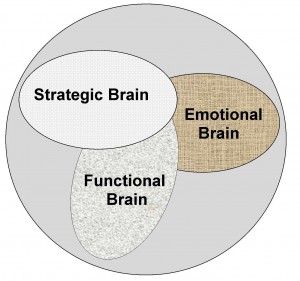
The 3 Brain Model for Conflict (3BMC) is a model based upon the Triune Brain theory created by Paul D. Maclean. The triune brain consists of the reptilian complex, the paleomammalian complex (limbic system), and the neomammalian complex (neocortex), viewed as structures sequentially added to the forebrain in the course of evolution.
The 3BMC consists of the Strategic Brain, the Emotional Brain, and the Functional Brain. These brains are roughly analogious to the neocortex, the limbic system, and the reptilian complex. But there are differences.
The 3BMC is a model to explain and maximize human conflict potential. Unlike the Triune Brain theory, it is not designed to explain the over all functioning of the human brain.
For the purposes of 3BMC, the Strategic Brain is responsible for creating strategy through conscious decision making. The Emotional Brain provides the energy that motivates a person into action, or inhibits the person into a frozen state. The Functional Brain provides lightning fast decision making and automatic accomplishment of instinctive and learned tasks.
Each brain has unique strengths and weaknesses. 3BMC postulates these characteristics to maximize potential and minimize weakness in both training and actual conflict.
For example, the Functional Brain has the unique ability to truly multi-task and manage multiple complex physical tasks at the same time. The Functional Brain allows a person to ride a unicycle, while balancing a plate on his head, while juggling three balls.
The Functional Brain is similar to an internet connection. It’s power can be split multiple times and it is still be able to perform tasks. But the individual performance degrades each time another task is added. While the Functional Brain can perform complex tasks and decision making rapidly, there are many tasks it simply cannot perform regardless how simple. In some respects, the Functional Brain may be thought of as an Idiot Savant.
The Emotional Brain manages the output of emotional energy. While it is possible to have multiple emotions at one time. The emotions are similar to waves. They can add up to create a tsunami or energy or cancel each other out to create a flat line of low energy. In addition, certain emotions are mutually exclusive. It is not possible to both be happy and sad from the exact same stimulus. The Emotional Brain has the ability to generate a tremendous amount of motivational energy or suck up a huge amount of the entire brain’s resources.
The Strategic Brain is the planner. It creates the strategies and is constantly looking for opportunities to defeat the opponent.
The Strategic Brain is the reason a person is able to defeat an opponent that is stronger and faster. The Strategic Brain outsmarts him and decides to use a weapon. But the Strategic Brain is slow to react and make decisions. It also can only concentrate at one task at a time. That is why Strategic Brain actions need to follow one after the other. They cannot happen at the same time.
Depending upon the circumstances, the 3 Brains may all work together, against each other, independently, or some variation of the previous states. Which brain is dominant at any given time changes from stimulus to stimulus and from person to person. A stimulus that may invoke minutes long Emotional Brain dominance resulting from extreme terror in a teenage girl may invoke a momentary Functional Brain trained response from a professional soldier. Meanwhile the Strategic Brain of a bystander may be slowly pondering what exactly is going on.
The generally accepted theory is that the Reptilian complex is responsible for self-preservation, aggression, and the Fight or Flight response. As a result, fine motor skills will diminish and only gross motor skills will be useful in a combat situation.
Most martial artists and combatives practitioners seem to acknowledge this fact. But, then they tend to go right back to training and fighting in whatever style and using the techniques they like the best. They also tend to instruct their students on their personal favorite techniques without taking into consideration the students differing physical and psychological makeup.
The 3BMC states that the brain system is constantly transitioning from one state to the other. Each state has a different order of dominance of the three brains for varying lengths of times from split seconds to minutes. And even when subordinate, each of the 3 Brains is busy working on accomplishing some task. Therefore, when the 3 Brains are working together at maximum capacity the entire brain system is capable of multi-tasking and rapidly handling complex tasks. When the 3 Brains are completely out of sync, the entire brain system can become stuck in a catatonic state.
In terms of combat, it is not enough to simply say that the Reptilian brain automatically takes over and handles the situation. The 3BMC goes further and states that the Functional Brain becomes momentarily dominate subject to the interruptions of the Strategic Brain. The actions performed by the Functional Brain are heavy influenced by the emotional energy generated by the Emotional Brain and the effects of the prior training that permanently altered the skills of the Functional Brain.
What all of the above means is that the exact same stimulus can have a widely varying effect on different people. This same stimulus can produce a varying effect on the same person over different time periods. It depends upon how the persons experiences and learning have changed the responses of the 3 Brains.
Video Links
The Paired Opposite Emotions of the Emotional Brain
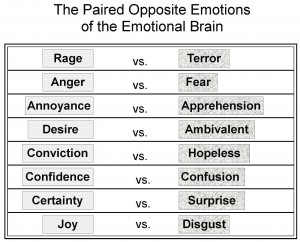
The above emotions are paired opposites because they are mutually exclusive in most instances. For example one stimulus can not invoke the emotions of both confidence and confusion at the EXACT same time.
While there are other emotions, these emotions are the ones most invoked in situations of interpersonal human conflict.
The emotions are centered in the Emotional Brain which is roughly equivalent to the Limbic system, mid-brain, or mammalian brain. The emotions can also be thought of as emotional energy. The emotions both produce energy in the form of motivating physical action and use energy in the form of taxing the resources of the entire Three Brain Model for Combat.
Each emotion emits and uses a different amount of energy. Rage and Terror both emit and use a large amount of energy, while Certainty and Ambivalent emit and use less. When the Emotional Brain uses less resources there are more resources available to be used by the Strategic Brain and the Functional Brain.
The Emotional Brain Proximity Principle

In a hand-to-hand physical conflict, the proximity and distancing of one combatant relative to the other is determined foremost by the combatant’s Emotional Brain despite causing a detriment to his tactical application of technique.
For example, as one combatants Emotional Brain desire to cause injury to the other increases, he will close the distance between himself and his opponent until he reaches a position of emotional equilibrium. Conversely, as his desire to cause injury decreases or is replaced by fear he will seek to place more distance between himself and his opponent.
The result is that the combatants will rarely position themselves optimally for the application of the most effective tactic or technique. They will place themselves where their Emotional Brain wants them to be as opposed to where they tactically should be. This situation has the potential of causing the Strategic Brain, Functional Brain, and the Emotional Brain to be at odds with each other.
For example, the Strategic Brain may realize that when an attacker has a club it is best to be very close or very far away. But the Emotional Brain may not have the Conviction to close the gap, and also may have too much Anger to move back sufficiently. Therefore, the Emotional Brain may place the person in a position that is too close for the Strategic Brain to respond to an attack, and too far for the Functional Brain to “sense the attack”.
Another example is when an emotionally angry man armed with a firearm is approached by a man with a knife. The presence of his loaded fire arm gives the gun wielder confidence. His aggravated Emotional Brain wants to move forward toward the man with thr knife. Without the emotional pull of anger, his Strategic Brain would tell him that he is getting too close. But his emotions of confidence and anger bring him beyond what would be considered a tactically safe distance.
A third example is application of control techniques that require close contact and sticking pressure with the other combatant. If one combatant is fearful of the other, despite his Strategic Brain’s and Functional Brain’s knowledge of where to properly position his body, he will place himself outside of the most effective radius to perform the recalled technique.
In an in-fighting situation, an angry attacker will continue to move closer to his opponent until his Emotional Brain reaches the desired positioning. If the opponent then attempts to bring the attacker even closer, the attackers Emotional Brain response will be to pull back from the opponent. It is a this exact moment of pulling back that the attacker’s Emotional Brain has switched from IN to OUT, from Anger to Fear, from attacking to defending.
This is the moment for the opponent to unleash a furious counter attack in order to exploit the attacker’s momentary weakness. If the opponent is able to take advantage of this moment, he should be able to create an increasing spiral of fear that will cause the attacker to retreat further and thus create more opportunity for his opponent.
The Combatant's Continuum
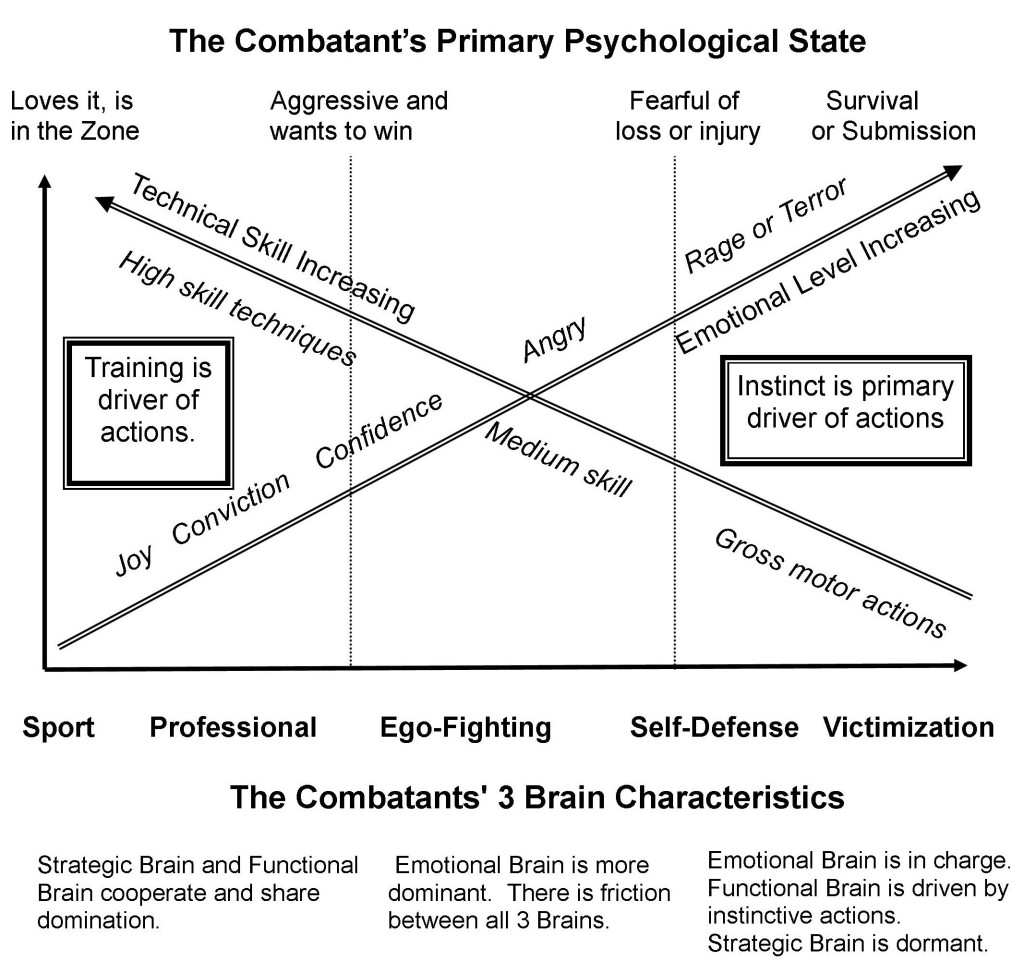
The Combatant’s Continuum is a model designed to explain the effect of a fighter’s psychology during both a single "fight" and an entire spectrum of "fights". It is based upon the following premises:
1. The ability of a combatant to execute trained skills and techniques decreases as his Emotional Brain becomes more dominant - either more fearful or more angry.
2. The technical/skill level of exhibited in sport fighting in general is higher than ego fighting. The technical/skill level exhibited in ego fighting is higher than exhibited in self-defense.
3. The sport fighter’s Emotional Brain becomes more dominant as the sport fighter becomes fearful of losing the match.
4. The emotional level of sport fighting in general is less than ego fighting which is less than self-defense.
5. At the highest skill level of fighting, the fighter’s Functional Brain and Strategic Brain transition smoothly back and forth in dominance. The Emotional Brain emits Confidence, Conviction, and Certainty. The actions directed by the Functional Brain and the Strategic Brain are the result of long term practice and experience.
6. This state differs drastically from an extreme level of active physical self-defense where the combatant’s Emotional Brain has switched from Fear/Terror to Anger/Rage. This switch has been initiated by his Emotional Brain’s desire to survive. The Functional Brain is dominant and executing instinctive survival actions.
Related concepts:
7. The ego is associated with fear of loss and progressively lower skill levels.
8. The so called “aggressive killer instinct” is not associated with the absolute highest skill level.
9. It is the “love for the process” that brings about the absolute highest skill level.
10. Relaxation during a sport competition is a product of both having confidence, conviction, and joy combined with having a higher skill level than one’s opponent.
11. The fearful emotions will prevent the combatant from obtaining the highest skill level.
By using this model, a combatant can make sense of all varied and sometimes conflicting advice on how to be a fighter. He can also use it to analyze what went right and what went wrong during any particular fight or time period in the fight.
The two emotions of fear and anger create weakness. Experienced fighters will create these emotions in opponents. Anger is the Ego which is also about “fear of loss” in this case it is known as pride. Anger is incompatible with “relaxed poise”. Fighter’s will talk in terms of both the importance of “the killer instinct”, “wanting to destroy the opponent” and also being “calm and relaxed”.
It appears that this advice is contradictory unless you consider that it all depends upon who the opponent is, what type of fight it is, and where the fighter is along the combatant’s Continuum.
In other words: depending upon your skill level, the skill level of your opponent, the outcome (do you lose or do you die?), your physical attributes, your opponents physical attributes, etc:
- sometimes you need to be calm and relaxed,
- sometimes you need to want to destroy your opponent,
- sometimes you need to have no emotion,
- sometimes you need to draw upon emotion created by the Emotional Brain
- sometimes you need to be consciously thinking with the Strategic Brain,
- sometimes you need to subconsciously use the Functional Brain,
- sometime you are “in the zone”,
- sometimes you can’t get “into the zone”.
It depends upon the circumstances. The Combatant’s Continuum is a model to help explain the circumstances.
Putting it All Together
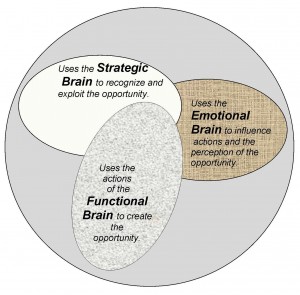
The entire purpose of the 3 Brain Model for Conflict is to use it as a tool to provide a greater understanding of how a person can maximize his or her fighting potential.
The 3 Brain Model for Conflict is intended to encourage a person to develop each of his 3 Brains to it’s full potential. The 3 Brains need to be developed individually. They also need to be trained to work together in harmony. The Functional Brain has the greatest ability for executing physical tasks. But despite it’s incredibly fast speed and decision making, the Functional Brain can only do either what instinct has hard wired or what it has been trained to do over a extended period of time. For example, you may intellectually know how to ride a bike, juggle, or swim. But no amount of book knowledge will enable you to ride a bike. The Functional Brain learns only by doing.
When it comes to conflict, the Functional Brain will be doing the initial work. It is the job of the Functional Brain to weaken, off-balance, and momentarily slow the opponent. Thereby providing the time for the Strategic Brain to recognize opportunity and decide on the next best course of action.
That action could be a devastating blow to a targeted area, a take-down, control move, a disengagement, or other action.
The Strategic Brain is too slow and deliberate to usually create opportunity at a sudden outset of a physical conflict such as an ambush. To try to do so, would mean forcing the action, a recipe for failure.
That being said, the Strategic Brain is needed to end the fight. The typical Functional Brain doesn’t know how to end the fight because it hasn’t enough actual or training experience doing it. Actual devastating strikes and attacks to vital areas cannot be trained by repetition It is too dangerous and impractical. Therefore, these actions are trained by the Strategic Brain via simulation.
The Emotional Brain provides the energy and motivation for actions to happen. A person’s Functional Brain may know how to walk along a six inch wide beam. But if the beam is located hundreds of feet in the air, it is unlikely that the person will attempt it.
The Emotional Brain will stop the person from trying. Even if the person is a highly trained gymnast, if he or she has a fear of heights, it is doubtful that any amount of convincing from the Strategic Brain will be enough.
The Emotional Brain also decides whether the actions recalled and executed will be trained or instinctive. A joyful or calm Emotional Brain leads to smoothly functioning trained actions.
A terrified or engaged Emotional Brain leads to spontaneous instinctive actions. These actions could be entirely appropriate for the circumstances, or they could be the worst possible. They is no way to determine. Therefore, the Emotional Brain must be conditioned (trained) and optimized along with the other brains.
Video Links:
The 3 Brains Ride a Bike
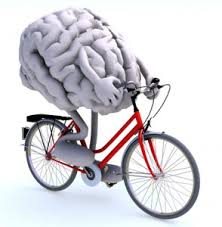
Before looking at the 3 Brains in terms of interpersonal human conflict it is useful to examine them in terms of something almost everyone can related to - riding a bike.
You are happily gliding down a steep hill on your bike in the city. Suddenly you realize that your brakes have failed. You are accelerating down the street towards a busy intersection and you are unable to slow yourself down.
While your Functional Brain is controlling the operation of the bike, your Strategic Brain frantically tries to determine a solution to the problem. When the brakes first failed your Emotional Brain transitioned from joy to apprehension and it is now moving towards fear.
You hit a pot hole in the roadway and almost fall. But the lightning fast reactions of the Functional Brain keeps the bike upright. The Functional Brain is focused on riding the bike. Left in control it will drive the bike straight through the intersection. But your Strategic Brain knows better. It identifies the impending danger and has determined that you need to dump the bike on it’s side to stop. The pot hole was the perfect opportunity to let the bike fall. But your Emotional Brain was too fearful to commit to the fall and your Strategic Brain was too slow to take advantage of the opportunity.
Your 3 Brains are in a state of disharmony. Your Strategic Brain and Emotional Brain are in direct conflict. Your Functional Brain continues to keep the bike upright and headed down the hill towards the dangerous intersection despite the impending danger. At some point, your Emotional Brain’s fear of falling will be overcome by it’s greater fear of colliding with the fast moving cars in the intersection.
At that point your Strategic Brain and Emotional Brain will agree on a course of action. Your Strategic Brain will take over operation of the bicycle and you will either consciously dump it on the street, or you will ride it into an obstacle to stop the bike.
Alternatively, your Emotional Brain will be so terrified that your Strategic Brain becomes dormant. In this situation, your Functional Brain will attempt to ride the bike directly through the intersection. The Functional Brain knows how to ride a bike, but it doesn’t know how to just let it fall.
As you come to the intersection, you see a car coming directly towards you. Your Functional Brain and Emotional Brain react as one. The overriding instinctive reaction is to protect your head. As your hands fly up to your head, you lose control of the bike. You fall and slide through the intersection barely missing the car which passed in front of you a split second earlier.
As you come to a stop, your Emotional Brain is filled with joy. You survived. Your Strategic Brain wakes up and assesses the situation. Your Functional Brain focuses on the mundane tasks of getting up and walking away.
The end result of the experience is different for each brain. The Functional Brain didn’t learn anything. The Functional Brain needs lots of repetitions to learn. The fall was just a fall. The Strategic Brain now has new knowledge related to the experience for future decisions. But for the most part, the Strategic Brain already knew how to handle the situation. It was just unable to put it’s knowledge into a plan and then execute the plan quickly.
The Emotional Brain is the one that has been effected the most. It has learned what the experience of having no brakes on a steep hill feels like. It has learned either what a controlled fall feels like, or what an out of control fall feels like. In either case, the Emotional Brain now has a concrete experience to draw upon for future situations. Some people consider this learning to be emotional “conditioning”.
The Professional Fight
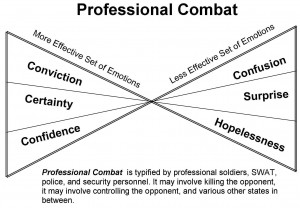
The scenario of the perfect fight provides an idealistic model for how the 3BMC applies to a conflict situation. In this scenario, the “Defender” is approached by the bad intentioned “Offender”. The Defender’s Strategic Brain makes a threat assessment. Due to his prior experience and training, the Defender determines that he can handle the situation. As a result, the Defender’s Emotional Brain feels certainty, confidence, and conviction and emits positive motivational energy. The defender’s Functional Brain is put on standby and is ready to take over.
The Defender’s Strategic Brain tries to defuse the situation and to deter an attack verbally. Despite this effort, the Offender attempts an assault. The Defender’s Functional Brain responds to the trigger of the pre-assault cue and launches a split-second counter attack. The lighting fast decision making and response of the Functional Brain takes the Offender by surprise. He is disoriented, off-balanced, and vulnerable.
The Defender’s Strategic Brain now has a moment to evaluate the situation and determine the next best course of action. The decision of whether to execute a take-down, control technique, or lethal blow can be made by the Strategic Brain due to the advantage of positioning and time created by the Functional Brain. The motivation to perform all of the above was due to the positive and highly efficient energy created by the Emotional Brain. The total time involved from pre-assault cue to finish is a few seconds.
Video Links
The Defensive Ego Fight
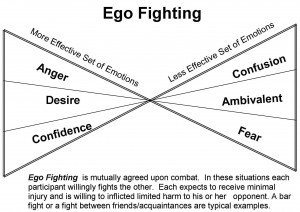
This hypothetical scenario demonstrates how the 3BMC works when events do not go as well as planned. Once again the Defender is approached by a bad intentioned Offender. But this time, the Defender’s Emotional Brain responds with fear and apprehension. This energy causes the Emotional Brain to dominate and the Strategic Brain and Functional Brain to become deeply subordinated.
When the Offender begins his physical assault, the Strategic Brain is too slow to respond to the obvious pre-assault cues. The Defender’s subordinated Functional Brain activates, but has barely enough time to instinctively “flinch” and get his hands up. As the Defender feels the impact and pain of the Offender’s attack, his Emotional Brain becomes switches from apprehension to anger. The energy created by anger drives the Defender into action. His Functional Brain executes instinctive anger related actions such as punching, kicking, and grabbing. The Defender’s prior training and experience many now come into play.
As his Functional Brain successfully executes actions, his Emotional Brain becomes more confident emitting positive energy. Eventually, the Defender is able to get the upper hand on the Offender. As in the previous scenario, his Strategic Brain now has the positioning and time to evaluate his next move, a take-down, control technique, or lethal blow. This scenario took considerably longer and involved much greater risk of the Defender receiving an injury than the previous Professional Fight.
Video Links
The Self-Defense Fight
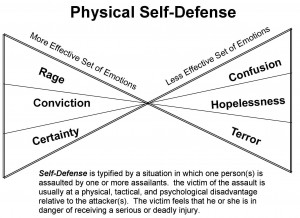
This third hypothetical scenario shows what happens when the fight is not a fight, but actually self-defense. The Defender is approached by the bad intentioned Offender. The Defender’s Strategic Brain’s threat assessment causes the Emotional Brain to jump to Fear. The Functional Brain responds to the Fear and waits for a either Flight or Freeze decision from the Strategic Brain or the Emotional Brain.
If the Defender’s Strategic Brain recognizes that the best course of action is to flee and makes the decision, then the Functional Brain will engage and flee. If the Strategic Brain is overwhelmed with Fear, it will become deeply subordinated and do nothing. Therefore, the decision to freeze of flee is made by the Emotional Brain. If her Emotional Brain associates Fear with flight she will run. But if her Emotional Brain associates terror with being still, she will be frozen in place.
When the Offender launches his attack. The Defender’s Emotion Brain goes from Fear to Terror. The Strategic Brain goes dormant. The Function Brain “ducks and covers”.
Reptilian theory postulates Flight or Fight. So where is the Fight? The Defender will not fight if his primary emotion is Terror. Once the Emotional Brain feels and emits Terror energy, his Emotional Brain must switch to Rage in order to Fight. Terror and Rage are mutually exclusive. Therefore, regardless of any previous training or experience, if the Emotional Brain is emitting Terror energy, the Defender will either Freeze or Flee, not Fight. The deciding factor is whether or not his Emotional Brain has learned to associate Terror with Freezing or Fleeing.
Given the previously described situation, the Defender’s only chance to save himself is if his Emotional Brain switches from Terror to Rage. The ability to make this switch is a function of the Emotional Brain’s desire and will to survive. What causes this desire varies from person to person, but it is an emotional attachment to living. Unless motivated to do something else by the Emotional Brain, the Functional Brain will continue to duck and cover, and the Strategic Brain will remain dormant.
Video Links:
Summary of the three hypothetical "fight" scenarios.
The previous scenarios are designed to show how the 3 Brains interact and function in different circumstances. The intent of 3BMC is to create training and conflict methods that capitalize on the strength and minimize the weaknesses of the 3 Brains.
From the scenarios described, each of the 3 Brains had a different degree of dominance and effect on the outcome.
In the first situation (Professional), the Emotional Brain had the minor role, while the trained Functional Brain provided the bulk of the opportunity for the Strategic Brain to finish the job.
In the second case (Ego), the Emotional Brain had a both hindering and helping effect on the Strategic Brain and Functional Brain to inefficiently complete the task.
In the final case (Self-defense), the state of the Emotional Brain determined the outcome. Both the Strategic Brain and the Functional Brain were overwhelmingly influenced by the energy of the Emotional Brain.
The Functional Brain

The Functional Brain is similar to an internet connection. It’s power can be split multiple times and it is still be able to perform tasks. But the individual performance degrades each time another task is added.
While the Functional Brain can perform complex tasks and rapid decision making, there are many tasks it simply cannot perform regardless how simple. In some respects, the Functional Brain may be thought of as an Idiot Savant.
The Emotional Brain

The Emotional Brain manages the output of emotional energy. While it is possible to have multiple emotions at one time. The emotions are similar to waves. They can add up to create a tsunami or energy or cancel each other out to create a flat line of low energy.
In addition, certain emotions are mutually exclusive. It is not possible to both be happy and sad from the exact same stimulus. The Emotional Brain has the ability to generate a tremendous amount of motivational energy or suck up a huge amount of the entire brain’s resources.
The Strategic Brain

The Strategic Brain is the planner. It creates the strategies and is constantly looking for opportunities to defeat the opponent.
The Strategic Brain is the reason a person is able to defeat an opponent that is stronger and faster. The Strategic Brain outsmarts him and decides to use a weapon. But the Strategic Brain is slow to react and make decisions. It also can only concentrate at one task at a time. That is why it is impossible Strategic Brain actions need to follow one after the other. They cannot happen at the same time.
Erik Kondo

If you think self-defense is mainly about physical fighting or that only those with a long history of personal involvement in violence have an opinion that is worthwhile, feel free to skip my contributions.
While I do have multiple years of training background in a variety of martial arts, particularly Small Circle jujitsu, my focus in on helping the average person make sense of self-defense.
I see self-defense as an extension of personal safety which is an extension of how you live your life. My goal is to help people learn to minimize the negative consequences of aggression and obtain peace of mind through developing better understanding, critical thinking and judgement in times of interpersonal conflict.